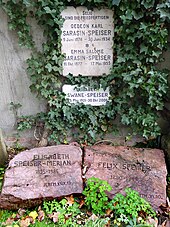Felix Speiser
Felix Speiser (born October 10, 1880 in Basel ; † September 19, 1949 there ) was a Swiss ethnologist ; Speiser studied and earned his doctorate in chemistry at the University of Basel . Later he also did his doctorate in Berlin in ethnology and then became a professor in Basel, where he was appointed director of the Völkerkundliches Museum.
biography

After attending school in Basel, Speiser studied chemistry in Neuchâtel, Göttingen and Basel. He traveled to America as an employee of the Geigy company. An earlier interest in ethnology moved him to devote himself entirely to this science, and so in 1906 he carried out a first study among the Hopi Indians of North America. 1907–1908 he studied ethnology at the Berlin Friedrich Wilhelms University and at the Royal Museum of Ethnology in Berlin under Felix von Luschan . After receiving his doctorate in ethnology in 1914, he was associate professor at the University of Basel from 1917.
Felix Speiser undertook several major research trips: 1910–1912 to Vanuatu ( New Hebrides ) and 1924 to northeast Brazil to the Aparai Indians (today's states of Amapá and Pará ).
1929–1930 Speiser traveled again to the Pacific to the islands of Bougainville and New Britain and to the Sepik Valley in New Guinea .
Speiser was director of the Museum der KulturenVölkerkundlichen Museum Basel , today's Museum of Cultures , from 1942 to 1949.
Fonts (selection)
- Ethnographic materials from the New Hebrides and the Banks Islands , Kreidel Verlag, Berlin 1923. (English translation: Ethnology of Vanuatu. An early twentieth century study. Crawford House, Bathurst NSW 1991, ISBN 1-86333-021-6 , p. 204–209 and panels 57–60. Reprints 1996 and 1998. Limited preview in Google book search)
- South Pacific, jungle, cannibals: travel impressions from the New Hebrides , Voigtländer Verlag, Leipzig 1913.
- About the initiations in Australia and Melanesia. (= Negotiations of the Natural Research Society in Basel ). Basel 1929.
- Introduction to the Museum für Völkerkunde Basel , Museum für Völkerkunde and Swiss Museum für Volkskunde, Basel 1939.
- Two Years with the Natives in the Western Pacific . Mills & Boon, London 1913.
reception
Speiser's work is characterized by reliability of observation and versatility. Forty years after his death, at the instigation of the Vanuatu government, his standard work on the New Hebrides was translated into English under the title Ethnology of Vanuatu .
literature
- Negotiations of the Natural Research Society in Basel 61, 1950, pp. 1–12 (with bibliography).
- Leonhard Adam: In Memoriam Felix Speiser . In: Oceania , Vol. 21, No. 1 (Sep., 1950), pp. 66-72.
- Berthold Riese: Speiser, Felix. In: New German Biography (NDB). Volume 24, Duncker & Humblot, Berlin 2010, ISBN 978-3-428-11205-0 , p. 653 f. ( Digitized version ).
- Jeroen Dewulf: Brazil with breaks. Swiss under the Southern Cross. Verlag der Neue Zürcher Zeitung, Zurich 2007, ISBN 978-3-03823-349-7 .
- Michael Kraus: educated citizen in the jungle. The German ethnological research on the Amazon (1848–1929). Curupira series, Marburg 2004, ISBN 3-8185-0397-4 .
Web links
- Literature by and about Felix Speiser in the catalog of the German National Library
- Felix Speiser's estate in the Basel University Library
- Christian Baertschi: Speiser, Felix. In: Historical Lexicon of Switzerland .
Individual evidence
- ↑ Lecture on the expedition given by Felix Speiser in Basel, 1925. Retrieved on June 3, 2020 .
- ↑ Stephanie-Thalia Dietrich: Cultural preservation or revitalization ?: The “shaman's bench” of the Aparai-Wayana of Brazil in the Rauschert Collection in the Bonn Old America Collection. Master's thesis , Grin Verlag, Norderstaedt 2009, pp. 33–34, ISBN 978-3-640-95195-6 .
- ↑ Christian Kaufmann: Art from Sepik. Ornament, sculpture and painting in competition. In: journal-ethnologie.de, focus topics 2007.
- ^ Leonhard Adam: In Memoriam Felix Speiser. In: Oceania , Vol. 21, No. 1 (Sep., 1950), pp. 66-72.
| personal data | |
|---|---|
| SURNAME | Speiser, Felix |
| BRIEF DESCRIPTION | Swiss ethnologist |
| DATE OF BIRTH | October 10, 1880 |
| PLACE OF BIRTH | Basel |
| DATE OF DEATH | September 19, 1949 |
| Place of death | Basel |
